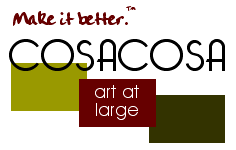



-G .F. W. Hegel
The ancient way of posing the problem of concreteness was in terms of the relation of being and thinking. The modern way, starting with Descartes, puts the issue in terms of the relation of subject and object, res cognitans and res extensa. In both cases, the issue tends to be posed by means of two terms alone, and the resulting reflection tends to be dogged by a certain dualism... Art and philosophy provide us with the modes of human activity corresponding to the epistemological powers we discover in intuition and the concept. Should we discover some continuity between them, then, important light may be thrown on the issue of concreteness. Put somewhat differently: Beside being and thinking, or the ontological and logical, the aesthetical might be introduced as an essential mediating term...
Given this focus, what, then, does the art work reveal to us concerning the nature of concreteness? At first the art work seems to present itself as an immediate material object, a mere objet d'art. Its concreteness seems to be just this, its simple empirical particularity. It seems to be the aesthetical version of the bare "this" of which Hegel speaks in the Phenomenology in terms of the object of sense-certainty. To this immediate concreteness is often ascribed art's positive power. The art work, it is said, impresses itself on us with sheer unmediated presence. Clearly, however, the concreteness of the art work cannot be identified with such an unmediated particularity. Were it so, it would exclude all internal complexity and immanent differentiation. It would cease to be a work, moreover a work of art; for sheer immediacy would not entail the mediating activity of its artistic originator. The art object is more complex and full than a bare "this" because it is a worked thing, a something made, a poiesis in the etymological sense. Its concreteness is that of a creation.
As such it involves a reference to the dynamic activity that originates it. An art work is the product of a process of origination and never can be fully understood in abstraction from this process. Its dynamic concreteness is just the fact that it is the sensuous embodiment of such a process of origination. Moreover, this dynamic concreteness is not blandly homogeneous. Tension is ingredient in its nature. If, for instance, we think of the artist wrestling with his materials, we conjure up the picture of such a struggle with sometimes disparate, sometimes opposing strands. The art work articulates and embodies something of this struggle. In sum, the art work makes concretely articulate a complex process of emergence both in the artist and his expressive powers, and in his material and its susceptibility for aesthetic form...
The form of the art work arises out of it immanently...a process of active formation. We do not discover a dualism of particular and universal, instance and form, the sensible and the intelligible. On the contrary, the art work tends to rescue particularity from arbitrariness, and universality from incommunicability. Again in the etymological sense, the art work might be seen as a poetic universal: the coming to emergence and concretion (poiesis) of a universal significance...
Another way we might put this point is by saying that the art work constitutes a kind of world. What is universal about it is its nature as an expressive universe, a rich and dense microcosm. As an individual whole, an expressive world, it telescopes within itself a sense of the whole. For Hegel this makes it to be the sensuous manifestation of Geist, the making concrete of Geist. The individual world of the art work is concrete spirit. It is the gathering of a rich unity of the activity of the spirit...the rich concreteness of the artistic microcosm awakens us to the analogous concreteness of the macrocosm, awakens us, in Hegelian terms, to the universe itself as a concretion of absolute spirit.
William Desmond, Ph.D., is Director of the International Program in Philosophy at the Centre for Metaphysics and Modern Philosophy of Katholieke Universiteit (Leuven, Belgium), This excerpt is from an essay, "Art, Philosophy, and Concreteness in Hegel," originally published in The Owl of Minerva, (spring 1985; volume 16, #2), the official journal of The Hegel Society of America.